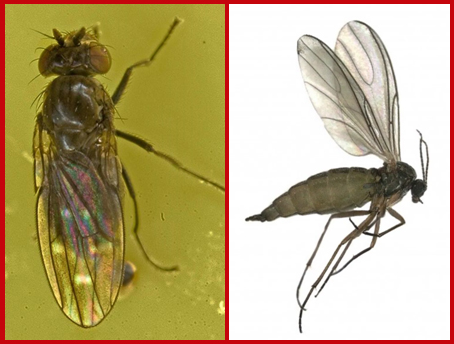
Shore fly (Scatella stagnalis) is a species of greenhouse nuisance fly that thrives in overwatered conditions where algae takes hold. Damage due to shore fly infestation is often, but not always, aesthetic, where large numbers of shore flies result in “flyspeck”: deposits of insect frass on plant material and pots. For edible plants such as lettuce, this can result in fungal or microbial contamination or the spread of fungal plant pathogens. Shore flies themselves are even capable of spreading fungal spores. Thankfully, growers can take several straight-forward steps to quickly reduce shore fly populations in greenhouses.
Reduce moisture where possible – Algae is not just a source of food for shore flies; being semi-aquatic, the next generation of eggs is laid directly on algae and inside moist growing media. Allowing media to dry down periodically reduces both viable breeding areas and food sources.
Treat algae on hard surfaces such as floors and drains – Where a reduction in moisture is not feasible, such as in drains or under and baseboards and benches where evaporation may be limited, chemical cleaners and sanitizers should be used to remove algae or biofilm sludges that have built up in those locations.
Add a plant safe sanitizer to irrigation water – Adding a gentle sanitizer to irrigation water can help fight the buildup of biofilms and algae in irrigation lines, media, filters, and elsewhere. Sanitizers containing hydrogen peroxide and peroxyacetic acid, such as ZeroTol 2.0 and SaniDate 12.0, are labeled for plant contact and use in irrigation lines. These sanitizing agents break down quickly into oxygen, water, and carbon dioxide, leaving no residue on crops.
Include regular treatments with Steinernema carpocapsae nematode drenches – nematode drenches are important control strategies for a number of pests, but the appropriate species must be chosen for the target pest. Shore flies are controlled through the use of S. carpocapsae nematodes, which infect and kill the larval stage of this pest while in the media. A drench at seeding is recommended for lettuce grown in hydroponic environments. Nematode drenches can also be applied to under bench areas and even drains, though they should not be combined with cleaner or sanitizer treatments, as nematodes are delicate and will be damaged by contact with those chemicals.
Reach out to your Griffin sales rep for more info!
Product List
74-2104 – Horti-Klor, 1Gal
74-2124 – Strip-it Acid Cleaner, 2.5Gal
74-2040 – GreenClean Acid Cleaner, 5Gal
74-2045 – GreenClean Alkaline Cleaner, 5Gal
74-36602 – Green-Shield II, 1Gal
74-21101 – Kleengrow, 1Gal
71-3530 – SaniDate 12.0, 5Gal
71-35501 – ZeroTol 2.0, 2.5Gal
30C250 – NEMAforce SC, 250M
SB1012-01 – Exhibitline SC, 250M
70-2455 – Millenium, 5 trays 250M
BB-0036 – BioSC, 250M